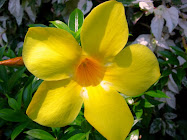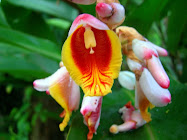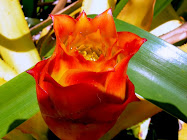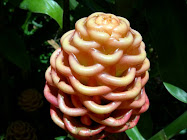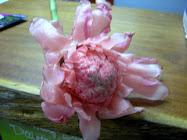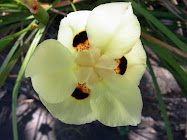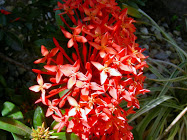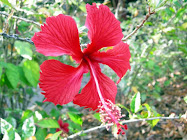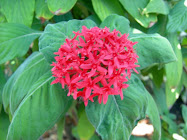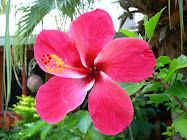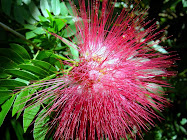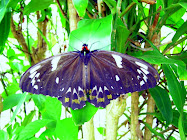Above: James Cook Museum
The James Cook Museum administered by the National Trust of Queensland is considered one of the most significant Trust Museums open to the public.
The building, designed by Scottish architect F D G Stanley was constructed in 1889 by the Catholic Church as St. Mary's Convent for the Sisters of Mercy and until the second world war was a major centre for the education of women in Far North Queensland. In 1960 the Catholic Church donated the building to the National Trust of Queensland.
Above: Altar
Altar-Convent This is the original altar that came from the convent chapel used by the Sisters of Mercy. The chapel would presumably have been in use from 1888. The museum building then was known as the "Convent of Saint Mary"
Above: Spiral Staircase
Used by the convent girls to access the attic. The nuns left the convent in 1941, and had the stairs dismantled and sent to their new location in Herberton. The stairs were later recovered and have come back "home" to the Cooktown convent/museum.
Above: Monstrance
The Ostensorium (Monstrance) From ostendere, "to show".
The large star shaped object is a Monstrance. A monstrance is the vessel used in the Roman Catholic, Old Catholic, and Anglican Churches to display the consecrated Eucharistic Host, during Eucharistic adoration or Benediction of the Blessed Sacrament.
From left to right, the objects are:
1. A votive lamp (candle) is a small, typically white or beeswax yellow, candle, originally intended to be burnt as a votive offering in a religious ceremony. It also refers to a standard size of candle 2 inches high by 1.5 inches diameter, of any color or scent.
2. An Urn used for burning ballot papers after the election of superiors.
3. Monstrance
4. Chalice
Above: H M Bark Endeavour (replica)
Built by Captain Dan Moynihan in 1915. This model of the Endeavour was used in Cooktown ceremonies.
Lieutenant James Cook sailed in the Endeavour on his first voyage of discovery to Australia and New Zealand from 1769 to 1771.
Above: Lighthouse Lamp
Above: Chinese Idols
These came from Cooktown's Chinese Joss House (Taoist/Buddhist temple), and would probably date from the Gold Rush days of the late 1800's.
Above: Very Early Telephone
Antique Phones No exact record available but possibly predate the switchboard (See next photo)
Above: Antique Phone Switchboard
Commissioned in 1873 by the Posmaster General to service ninety telephone subscribers. When the switchboard was decommissioned in June 1985 there were 400 subscribers to the now automatic exchange.
Above: Endeavour Harbour
This is a view of Endeavour Harbour from the balcony of the James Cook museum. The foreground building has no significance.
Above: Cooktown Garden
This lovely tropical garden was to the left side of the James Cook Museum as you faced the street. I took this from the upstairs balcony.
Tropical Far North Queensland
This is about my holiday from Cairns to
Laura, on the lower Cape York Peninsula from
September 2008 to October 2008. Going from Melbourne to Cairns to Port Douglas, to Cooktown and Laura, Cape Tribulation and all the bits in between, and finally back to Cairns for my flight home.
Cheers.
Laura, on the lower Cape York Peninsula from
September 2008 to October 2008. Going from Melbourne to Cairns to Port Douglas, to Cooktown and Laura, Cape Tribulation and all the bits in between, and finally back to Cairns for my flight home.
Cheers.
Drive The Daintree
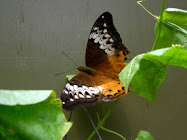
45. Town Walk
Cooktown is the northernmost town on the East coast of Australia, located at the mouth of the Endeavour River on the Cape York Peninsula in Far North Queensland.
History
In June, 1770, Captain James Cook arrived in the crippled sailing vessel – His Majesty's Bark Endeavour.
The English crew spent almost seven weeks on the site of the present day Cooktown, repairing their ship, locating food, and caring for the sick. The wealthy scientist, Joseph Banks, and naturalist Daniel Solander, who accompanied Cook on the expedition, went collecting, preserving and documenting many new species of plants.
Historical Buildings
Cooktown is an historical town and many of its fine old buildings have been preserved. The photos below were taken on my walk along Charlotte Street. I didn't get to see all of them as the weather was very hot and I only had a certain amount of time.
Above: The Old Bank
The magnificent Bank building, heritage listed both inside and out, was originally built in 1881 as the Queensland National Bank. Typical pf the Victorian era it still retains the original red cedar counters and other decor.
Above: Close-up of entrance
The banking chambers are home to photographic exhibitions conducted by the Cooktown Historical Society. With over 400 glass plate negatives the 2007 exhibition "Cooktown & Palmer - The Early Years" provides a glimpse of our pioneering past.
Above: Mrs. Watson's monument
~ Dedicated (c.1886) to Mrs. Watson who survived an Aboriginal attack on Lizard Island in September 1881 to die later on Number 5 Island of the Howick group for lack of fresh water. The wife of a beche-de-mer fisherman Captain R.F.Watson the attack on her was provoked because their homestead was built on sacred land. One of her two servants was speared but Mrs. Watson her infant son & the other Chinese servant escaped in a boiling down tank to Number 5 Island. Their remains & her diary were found in 1882.
Above: Ferrari Estates
Ferrari Estates was built in 1883 for the Bank of North Queensland.
Above: Sovereign Resort Hotel
Originally constructed in 1874, at the port end of Charlotte Street, the Sovereign was transformed into a resort style hotel in 1986.
Above: Seagren's Inn
Seagren's Inn was erected in 1880 by a former mayor, P.E.Seagren, as a store.
It is now a motel/guest house and goes by the name of Chop Suey Louie's
History
In June, 1770, Captain James Cook arrived in the crippled sailing vessel – His Majesty's Bark Endeavour.
The English crew spent almost seven weeks on the site of the present day Cooktown, repairing their ship, locating food, and caring for the sick. The wealthy scientist, Joseph Banks, and naturalist Daniel Solander, who accompanied Cook on the expedition, went collecting, preserving and documenting many new species of plants.
Historical Buildings
Cooktown is an historical town and many of its fine old buildings have been preserved. The photos below were taken on my walk along Charlotte Street. I didn't get to see all of them as the weather was very hot and I only had a certain amount of time.
Above: The Old Bank
The magnificent Bank building, heritage listed both inside and out, was originally built in 1881 as the Queensland National Bank. Typical pf the Victorian era it still retains the original red cedar counters and other decor.
Above: Close-up of entrance
The banking chambers are home to photographic exhibitions conducted by the Cooktown Historical Society. With over 400 glass plate negatives the 2007 exhibition "Cooktown & Palmer - The Early Years" provides a glimpse of our pioneering past.
Above: Mrs. Watson's monument
~ Dedicated (c.1886) to Mrs. Watson who survived an Aboriginal attack on Lizard Island in September 1881 to die later on Number 5 Island of the Howick group for lack of fresh water. The wife of a beche-de-mer fisherman Captain R.F.Watson the attack on her was provoked because their homestead was built on sacred land. One of her two servants was speared but Mrs. Watson her infant son & the other Chinese servant escaped in a boiling down tank to Number 5 Island. Their remains & her diary were found in 1882.
Above: Ferrari Estates
Ferrari Estates was built in 1883 for the Bank of North Queensland.
Above: Sovereign Resort Hotel
Originally constructed in 1874, at the port end of Charlotte Street, the Sovereign was transformed into a resort style hotel in 1986.
Above: Seagren's Inn
Seagren's Inn was erected in 1880 by a former mayor, P.E.Seagren, as a store.
It is now a motel/guest house and goes by the name of Chop Suey Louie's
44. Pam's Place
Cooktown Accommodation
This is where I stayed in Cooktown. Pam's Place is both a hotel and hostel. The hostel is YHA affiliated and the cost very reasonable. It was $25 per night when I stayed here in 2008 and I can honestly recommend it. Pam's Place is on the corner of Charlotte Street and Boundary Street. Charlotte Street is the main road in Cooktown and is on the right hand side as you arrive in Cooktown from Cairns.
Above: Entrance
The huge crocodile on the right is quite welcoming and best of all, he doesn't bite!
Above: Murals
This is part of the colourful hand-painted mural near the reception area. Scott (the owner) told me one of the backpackers who from memory was Austrian asked to paint the walls. And what a wonderful job she did too.
Above: Communal Areas
The top left photo is part of the dining area and the one on the right shows the inside/outside lounge/games area. Lower left is part of the kitchen which is all stainless steel, clean and has a very good selection of pots and pans etc. The lower right is the ladies bathroom. Note the painting on the wall - it is the first thing you see on entering! I never did find out who the model was but he had a nice figure.☺ (The ladies used to often gaze upon this painting...I wonder why)
Above: My room
The room was fairly basic, but it was clean and the mattress was comfortable. A small bar fridge, hanging and shelf space for your clothes etc and a lovely still life painting on the wall. I was in Room 16? (not sure of the number) which was off the side and to the left. There was a nice covered area outside with a couple of timber table and chairs where I would sit and have a cup of tea and a smoke. The view was of plants, flowers and greenery.
Garden Areas
The garden areas around Pam's Place were very lush and green with tropical plants. There was, I beleive, a pool although I didn't use it, there is also a BBQ, which I didn't use either.
Above: The Gazebo
This gazebo is towards the end of the garden. The building on the right is part of the hotel section.
Above: Tall Palms
Above: Garden Collage
Different parts of the garden. There were several hibiscus growing, some with massive flowers and a Chinese (or Japanese) section with garden statues in and around the plants. The lattice with the Welcome ornament was on the wall of the verandah facing the gardens.
This is where I stayed in Cooktown. Pam's Place is both a hotel and hostel. The hostel is YHA affiliated and the cost very reasonable. It was $25 per night when I stayed here in 2008 and I can honestly recommend it. Pam's Place is on the corner of Charlotte Street and Boundary Street. Charlotte Street is the main road in Cooktown and is on the right hand side as you arrive in Cooktown from Cairns.
Above: Entrance
The huge crocodile on the right is quite welcoming and best of all, he doesn't bite!
Above: Murals
This is part of the colourful hand-painted mural near the reception area. Scott (the owner) told me one of the backpackers who from memory was Austrian asked to paint the walls. And what a wonderful job she did too.
Above: Communal Areas
The top left photo is part of the dining area and the one on the right shows the inside/outside lounge/games area. Lower left is part of the kitchen which is all stainless steel, clean and has a very good selection of pots and pans etc. The lower right is the ladies bathroom. Note the painting on the wall - it is the first thing you see on entering! I never did find out who the model was but he had a nice figure.☺ (The ladies used to often gaze upon this painting...I wonder why)
Above: My room
The room was fairly basic, but it was clean and the mattress was comfortable. A small bar fridge, hanging and shelf space for your clothes etc and a lovely still life painting on the wall. I was in Room 16? (not sure of the number) which was off the side and to the left. There was a nice covered area outside with a couple of timber table and chairs where I would sit and have a cup of tea and a smoke. The view was of plants, flowers and greenery.
Garden Areas
The garden areas around Pam's Place were very lush and green with tropical plants. There was, I beleive, a pool although I didn't use it, there is also a BBQ, which I didn't use either.
Above: The Gazebo
This gazebo is towards the end of the garden. The building on the right is part of the hotel section.
Above: Tall Palms
Above: Garden Collage
Different parts of the garden. There were several hibiscus growing, some with massive flowers and a Chinese (or Japanese) section with garden statues in and around the plants. The lattice with the Welcome ornament was on the wall of the verandah facing the gardens.
43. Cooktown
Monday 29 September
We arrived in Cooktown at 1.25pm. Checked into the YHA (Pams Place) on the corner of Boundary Street and Charlotte Street. Scot, the owner was a friendly chap and when I said, "Phew it's so hot", his answer was, "Oh no, this isn't hot dear, this is only warm!"
He drove me down to the car hire place - A1 Car Hire - but somebody stuffed up and there was no car for me. I had booked a 4WD automatic several months prior and Joe couldn't find it. I told him I had a copy of the email back at the hostel and could go and get it if necessary. AFter soime checking on his computer, he found it. He said they no longer had those type of 4WD's - the booking had been done through the head office in Cairns. The 4WD auto was in Cairns and he'd have to get someone to drive it up and I would be able to pick it up early next morning.
He gave me the use of an ordinary car, a Hyundi Sonata, but the problem was you could only drive it around town. He said he wouldn't charge me a hire fee, just pay for the petrol.
Went to the Bakery and had a coffee and cake for $6.50 and bought a corkscrew at the IGL Supermarket for $6 - I'd forgottne to bring one with me and had a nice bottle of wine.
The best place for a meal is the Cooktown Bowling Club - beaut home cooked meals just $12. I had Beef and vegies and the most delicious cheesecake which was $6.50.
Joe (from A1 Car hire) drove me up Grassy Hill (in his 4WD) to see the lighthouse (No 2WD's allowed) and watch the sunset.
Cooktown Lighthouse
The Lighthouse is located on Grassy Hill which is at the eastern end of Hope Street. The lookouts provide panoramic views of Cooktown, the Endeavour River & Coral Sea. James Cook climbed the hill on several occasions to view the surrounding reefs enabling him to navigate a safe passage out after repairing his ship. The lighthouse was built in England & shipped to Cooktown in 1885 & was automated in 1927. Between 1942-45 it was complemented by a radar station & dismantled after WW2 & served the community for 100 years.
We arrived in Cooktown at 1.25pm. Checked into the YHA (Pams Place) on the corner of Boundary Street and Charlotte Street. Scot, the owner was a friendly chap and when I said, "Phew it's so hot", his answer was, "Oh no, this isn't hot dear, this is only warm!"
He drove me down to the car hire place - A1 Car Hire - but somebody stuffed up and there was no car for me. I had booked a 4WD automatic several months prior and Joe couldn't find it. I told him I had a copy of the email back at the hostel and could go and get it if necessary. AFter soime checking on his computer, he found it. He said they no longer had those type of 4WD's - the booking had been done through the head office in Cairns. The 4WD auto was in Cairns and he'd have to get someone to drive it up and I would be able to pick it up early next morning.
He gave me the use of an ordinary car, a Hyundi Sonata, but the problem was you could only drive it around town. He said he wouldn't charge me a hire fee, just pay for the petrol.
Went to the Bakery and had a coffee and cake for $6.50 and bought a corkscrew at the IGL Supermarket for $6 - I'd forgottne to bring one with me and had a nice bottle of wine.
The best place for a meal is the Cooktown Bowling Club - beaut home cooked meals just $12. I had Beef and vegies and the most delicious cheesecake which was $6.50.
Joe (from A1 Car hire) drove me up Grassy Hill (in his 4WD) to see the lighthouse (No 2WD's allowed) and watch the sunset.
Cooktown Lighthouse
The Lighthouse is located on Grassy Hill which is at the eastern end of Hope Street. The lookouts provide panoramic views of Cooktown, the Endeavour River & Coral Sea. James Cook climbed the hill on several occasions to view the surrounding reefs enabling him to navigate a safe passage out after repairing his ship. The lighthouse was built in England & shipped to Cooktown in 1885 & was automated in 1927. Between 1942-45 it was complemented by a radar station & dismantled after WW2 & served the community for 100 years.
42. Bloomfield River
Monday 29 September
The Bloomfield River is 60 odd kms south of Cooktown and Allan stopped for a photo view.
Ze Bus
This was our bus.
Bloomfield River
The river enters the sea north of Cape Tribulation and is noted for its Bloomfield River cod fish species, found only in the river.
It was originally named "Blomfield's Rivulet" on 26 June, 1818 by Phillip Parker King.
Bloomfiled River & Hills
It was a beautiful scenic spot and the water appeared to be so blue.
The Bloomfield River is 60 odd kms south of Cooktown and Allan stopped for a photo view.
Ze Bus
This was our bus.
Bloomfield River
The river enters the sea north of Cape Tribulation and is noted for its Bloomfield River cod fish species, found only in the river.
It was originally named "Blomfield's Rivulet" on 26 June, 1818 by Phillip Parker King.
Bloomfiled River & Hills
It was a beautiful scenic spot and the water appeared to be so blue.
41. Wujal Wujal
Monday 29 September
We made our second break at Wujal Wujal and I bought dim-sims and a nice hot cuppa tea - it was the best tea and I really enjoyed it. We sat outside and it was very relaxing after bouncing around on the bus.
At Viv's Cafe you can get chicken and chips, hamburgers, chips, dim sims, cold drinks, coffee and tea. I bought dim-sims and a nice hot cuppa tea - it was the best tea and I really enjoyed it.
You can rest a while and you can talk to the locals. You can also look at the history of the old days in Bloomfield. There are toilets provided for and every second Saturday a market is held there.
The Ayton store is a small shop on the right hand side of the road where you can buy food and drinks. There's a cafe called the Croc and Barra Cafe which sells takeaway food and drinks. There's a nice outdoor eating area with shade.
The Aboriginal police woman came up while we were there and said hello.
We made our second break at Wujal Wujal and I bought dim-sims and a nice hot cuppa tea - it was the best tea and I really enjoyed it. We sat outside and it was very relaxing after bouncing around on the bus.
At Viv's Cafe you can get chicken and chips, hamburgers, chips, dim sims, cold drinks, coffee and tea. I bought dim-sims and a nice hot cuppa tea - it was the best tea and I really enjoyed it.
You can rest a while and you can talk to the locals. You can also look at the history of the old days in Bloomfield. There are toilets provided for and every second Saturday a market is held there.
The Ayton store is a small shop on the right hand side of the road where you can buy food and drinks. There's a cafe called the Croc and Barra Cafe which sells takeaway food and drinks. There's a nice outdoor eating area with shade.
The Aboriginal police woman came up while we were there and said hello.
40. Wujal Wujal Aboriginal Community
Monday 29 September
Wujal Wujal means ‘land of plentiful water’ and is on the Bloomfield Track 60 kms south of Cooktown. Wujal Wujal was previously known as Bloomfield and later the Bloomfield River Mission. Originally founded in 1886 by Lutheran missionaries, the community became too difficult to administer due to its isolation and the missionaries of the time withdrew. The community opened again in 1957 and was administered by the Hopevale Mission Board. In 1979 the name was changed from Bloomfield River to Wujal Wujal. At the 2006 census, Wujal Wujal had a population of 326. The people are Kuku Yalanji.
Wujal Wujal
Visitors are warned not to bring any alcohol into the community as part of the Queensland governments aims at tackling aboriginal alcohol abuse.
Wujal Wujal artists Glen Williams and Doreen Creek worked with teacher Ross Franzi to create the tiles representing the communities’ cultural past and their future.
In 1980 the Aboriginal Council came into being, with the area regaining its traditional name, Wujal Wujal. The community has an Indigenous Knowledge Centre "Binal Mangka Bayan" (which means house of knowing things). The centre provides access to books, magazines and other educational material.
Wujal Wujal Crossing
Getting to Wujal Wujal is by an unsurfaced track road which is only suitable for 4WD's due to the gradient of the terrain and the numerous streams and rivers which cross the path at regular intervals. The road is unpassable when there's heavy waterflow.
Wujal Wujal Falls
The community at Wujal Wujal is thought to have existed on the site for thousands of years and in their eyes the waterfalls are sacred. Visitors are only permitted access to one waterfall as the other falls are only for the eyes of the female members of the community. There have been cases where non-aboriginal women have built a strong relationship with the community and been granted access to the falls however the Aboriginals insist that the other women be naked and coated in a layer of saliva from the aboriginal women.
Map
Wujal Wujal means ‘land of plentiful water’ and is on the Bloomfield Track 60 kms south of Cooktown. Wujal Wujal was previously known as Bloomfield and later the Bloomfield River Mission. Originally founded in 1886 by Lutheran missionaries, the community became too difficult to administer due to its isolation and the missionaries of the time withdrew. The community opened again in 1957 and was administered by the Hopevale Mission Board. In 1979 the name was changed from Bloomfield River to Wujal Wujal. At the 2006 census, Wujal Wujal had a population of 326. The people are Kuku Yalanji.
Wujal Wujal
Visitors are warned not to bring any alcohol into the community as part of the Queensland governments aims at tackling aboriginal alcohol abuse.
Wujal Wujal artists Glen Williams and Doreen Creek worked with teacher Ross Franzi to create the tiles representing the communities’ cultural past and their future.
In 1980 the Aboriginal Council came into being, with the area regaining its traditional name, Wujal Wujal. The community has an Indigenous Knowledge Centre "Binal Mangka Bayan" (which means house of knowing things). The centre provides access to books, magazines and other educational material.
Wujal Wujal Crossing
Getting to Wujal Wujal is by an unsurfaced track road which is only suitable for 4WD's due to the gradient of the terrain and the numerous streams and rivers which cross the path at regular intervals. The road is unpassable when there's heavy waterflow.
Wujal Wujal Falls
The community at Wujal Wujal is thought to have existed on the site for thousands of years and in their eyes the waterfalls are sacred. Visitors are only permitted access to one waterfall as the other falls are only for the eyes of the female members of the community. There have been cases where non-aboriginal women have built a strong relationship with the community and been granted access to the falls however the Aboriginals insist that the other women be naked and coated in a layer of saliva from the aboriginal women.
Map
39. Bloomfield Track
The Bloomfield Track runs from Cape Tribulation to the The Bloomfield River for 32 kms and is a true 4WD Track as there is very little gravel on parts of the surface, unimproved creek crossings, steep climbs and plenty of opportunity to get stuck if it is wet. The actual condition of the road varies enormously, and it can be anything from an easy drive, to almost or completely impassable.
Rykers Bridge
It was fun bouncing up and down and listening to the "squish" of tyres as they went through the water on the roads. There are two steep climbs and descents on the track — Donovan's Range is 20% (1:5), and Cowie Range is up to 33% (1:3).
Bloomfield Road Sign
Normally the creeks are alright, but in wet weather there can be at least 4 challenging crossings. Most 4WD vehicles can only cross about 0.6m depth of water before the risk of damage, and even if the vehicle is capable of a deeper crossing, the strong current can easily wash 4WDs away!
Bloomfield Track
There was a fair amount of water on the track and along the side. Sometimes the road sort of breaks up and you gets lots of mud. The road surface can be loose and slippery even when dry. At times I thought we weren't going to make it, but Allan, our driver knew the ropes having done this many times before. It wasn't till we arrived in Cooktown, that I realised Allan was not only our driver, but also the owner of the company.
Bloomfield Track
You can get lots of dust which blows up around.
Track History
The Bloomfield Track was pushed through from Cape Tribulation to Bloomfield in 1983. It was constructed amidst vehement protests from within the environment movement resulting in pitched battles at the site of construction between protesters and the police. Eventually the track was completed providing a 4wd thoroughfare from Cape Tribulation to just south of the Bloomfield River where it connected with an existing road which carried on through Ayton to connect with the Cape York Peninsula Developmental Road leading to Cooktown.
Rykers Bridge
It was fun bouncing up and down and listening to the "squish" of tyres as they went through the water on the roads. There are two steep climbs and descents on the track — Donovan's Range is 20% (1:5), and Cowie Range is up to 33% (1:3).
Bloomfield Road Sign
Normally the creeks are alright, but in wet weather there can be at least 4 challenging crossings. Most 4WD vehicles can only cross about 0.6m depth of water before the risk of damage, and even if the vehicle is capable of a deeper crossing, the strong current can easily wash 4WDs away!
Bloomfield Track
There was a fair amount of water on the track and along the side. Sometimes the road sort of breaks up and you gets lots of mud. The road surface can be loose and slippery even when dry. At times I thought we weren't going to make it, but Allan, our driver knew the ropes having done this many times before. It wasn't till we arrived in Cooktown, that I realised Allan was not only our driver, but also the owner of the company.
Bloomfield Track
You can get lots of dust which blows up around.
Track History
The Bloomfield Track was pushed through from Cape Tribulation to Bloomfield in 1983. It was constructed amidst vehement protests from within the environment movement resulting in pitched battles at the site of construction between protesters and the police. Eventually the track was completed providing a 4wd thoroughfare from Cape Tribulation to just south of the Bloomfield River where it connected with an existing road which carried on through Ayton to connect with the Cape York Peninsula Developmental Road leading to Cooktown.
38. North To Cooktown
Monday 29 September
It is just after 8.00am and the journey to Cooktown begins. Country Road Coachlines, a locally owned an operated company travels between Cairns and Cooktown - offering two routes, the inland service and the coastal service. The inland service is a same day run, but I chose the coastal route as I wanted to travel along the famed Bloomfiled Track. This is an overnight service, going Cairns to Cooktown on Monday, Wednesday and Friday, and returning to Cairns on Tuesday, Thursday and Saturday. Allan was our driver and he had a great sense of humour.
I had a migraine and most of the way was spent lying across the seats on the bus - self-inflicted I know. I really should have gone to bed earlier the night before, but you know how it is - you're on holiday and don't want to miss a minute of it. Ah well, c'est la vie!
Raintree's Cafe
Our first stop was at the Raintree Cafe about 9.00am for a bite to eat and a cuppa. I bought an egg sandwich and a cup of coffee for $8.00 which was just what was needed after an early start to the day. Allan was really good and didn't mind if you wanted to linger a bit to finish that last smoke, or make a quick dash to the loo.
Outdoor Dining Area
We sat here in the outdoor area - all the smokers congregated here, plus it was much nicer sitting outside with lots of greenery around. The timber tables were indifferent shapes and the air was warm with a faint breeze.
Daintree River Ferry Crossing
I awoke to the sound of the ferry and we waited out turn to cross. TGhe time was a little after 9.30am.
Route Map
This shows the coastal route from Cairns to Emmagen Creek and part of the Bloomflied Track.
It is just after 8.00am and the journey to Cooktown begins. Country Road Coachlines, a locally owned an operated company travels between Cairns and Cooktown - offering two routes, the inland service and the coastal service. The inland service is a same day run, but I chose the coastal route as I wanted to travel along the famed Bloomfiled Track. This is an overnight service, going Cairns to Cooktown on Monday, Wednesday and Friday, and returning to Cairns on Tuesday, Thursday and Saturday. Allan was our driver and he had a great sense of humour.
I had a migraine and most of the way was spent lying across the seats on the bus - self-inflicted I know. I really should have gone to bed earlier the night before, but you know how it is - you're on holiday and don't want to miss a minute of it. Ah well, c'est la vie!
Raintree's Cafe
Our first stop was at the Raintree Cafe about 9.00am for a bite to eat and a cuppa. I bought an egg sandwich and a cup of coffee for $8.00 which was just what was needed after an early start to the day. Allan was really good and didn't mind if you wanted to linger a bit to finish that last smoke, or make a quick dash to the loo.
Outdoor Dining Area
We sat here in the outdoor area - all the smokers congregated here, plus it was much nicer sitting outside with lots of greenery around. The timber tables were indifferent shapes and the air was warm with a faint breeze.
Daintree River Ferry Crossing
I awoke to the sound of the ferry and we waited out turn to cross. TGhe time was a little after 9.30am.
Route Map
This shows the coastal route from Cairns to Emmagen Creek and part of the Bloomflied Track.
Subscribe to:
Comments (Atom)













































